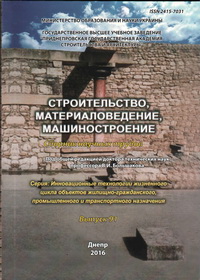Лстк method for determination of the probability of thermal failure of building envelopes made of steel cold-formed elements by using the thermal characteristics
Keywords:
thermal reliability, probability of failure, linear heat-conducting inclusions, variability, linearization, cold-formedAbstract
Annotation. The aim of the article is to develop a methodology for determining the probability of thermal failure of building envelopes made of cold-formed steel elements by using three thermal indicators. The relevance of the research. Design of building envelopes based on the deterministic approaches does not take into account the variability of many factors that affect the result of the calculation. Obtaining the mathematical apparatus to perform the probability calculations of envelopes will give an insight into the effect of the variability of different factors on the reliable operation of a heat-insulating cover. Methods: the study used methods of building thermal physics and the theory of reliability. Results. Method for determining the probability of thermal failure of building envelopes with linear heat-conducting inclusions by three thermal indicators. The practical significance of the received method of calculation is that a mathematical apparatus of evaluation of the effect of different factors and their variability on the faultness performance of building envelopes with heat-conducting inclusions, such as wall structures made of cold-formed steel elements, was received.References
DBN V.2.6-31:2006. Teplova izolyacia budivel [Thermal insulation of buildings]. – Kyiv. : Minbud. Of Ukraine, 2006. – 65 p. (in Ukrainian) Available at: http://old.minregion.gov.ua/attachments/files/bydivnitstvo/texnichneregulyuvannya/normuvannja/DBN%20V26312006.zip СТРОИТЕЛЬСТВО, МАТЕРИАЛОВЕДЕНИЕ, МАШИНОСТРОЕНИЕ. ВЫП. 91 -2016 ISSN 2415-7031 147
DBN V.2.6-31:2006. Teplova izolyacia budivel.Zmina #1 [Thermal insulation of buildings. Change #1] // Informaciynii buleten MRU [Newslatter MRU]. – № 5. – 2013. – P. 3–11. (in Ukrainian) Available at: http://old.minregion.gov.ua/attachments/files/bydivnitstvo/texnichne-regulyuvannya/normuvannja/DBN%20V26312006.zip
Pashynskyi V.A., Pushkar N.V. and Kariuk A.M. Temperaturni vplyvy na ogorodzhuvalni konstrukcii budivel [Temperature effects on the envelope of buildings]. – Odesa: ODABA, 2012. – 180 p. (in Ukrainian)
Pashynskyi V.A., Plotnikov O.A. and Kariuk A.M. Methodology of the evaluation of thermal reliability of the walls by the criteria of the heat losses // Mizhvuzivskiy zbirnyk «Naukovi notatky» [Interuniversity collection "Science notes"]. – Issue 45., - Lutsk, 2014. – pp. 417-423. (in Ukrainian) Available at: : http://www.irbis-nbuv.gov.ua/cgibin/irbis_nbuv/cgiirbis_64.exe?I21DBN=LINK&P21DBN=UJRN&Z21ID=&S21REF=10&S21CNR=20&S21STN=1&S21FMT=A SP_meta&C21COM=S&2_S21P03=FILA=&2_S21STR=Nn_2014_45_67
Pichigin S. F. Reliability of industrial building steel structures. – Moscow. : ASV, 2011. – 456 p. (in Russian)
Pichigin S. An Semko V. The probability of the thermal failure of building envelopes made of cold-formed steel elements based on local temperature decrease criterion // Collected scientific works of Ukrainian state university of railway. – Kharkiv, 2016. – Issue 160. – pp. 25-34. (in Ukrainian) Available at: http://csw.kart.edu.ua/article/view/69985
Farenuk G.G. Metodologichni aspekty zabezpechennya energoefektyvnosti ta teplovoi nadiynosti budynkiv [Methodological aspects of energy efficiency and thermal reliability of buildings] // Stroitelstvo, materialovedenie, mashinostroenie – [Сonstruction, materials science, mechanical engineering]. PDABA. Dnipropetrovsk, 2009, no. 50, pp. 593-597. (in Ukrainian)
Shul’hin V.V. and Kariuk A.M. Probabilistic presentation of heat insulation materials specifications // Academic Journal. Industrial Machine Building, Civil Engineering. – PoltNTU, 2013. – No. 4(39). – Volume 2. – pp.257-262. Available at: http://www.irbis-nbuv.gov.ua/cgibin/irbis_nbuv/cgiirbis_64.exe?I21DBN=LINK&P21DBN=UJRN&Z21ID=&S21REF=10&S21CNR=20&S21STN=1&S21FMT=A SP_meta&C21COM=S&2_S21P03=FILA=&2_S21STR=Znpgmb_2013_4(2)__34
Semko V.O., Leshсhenko M.V. and Rud A.G. Experimental study of variability of thermal conductivity of insulation materials // Academic Journal. Industrial Machine Building, Civil Engineering. – PoltNTU, 2016. – No. 1(46). – pp.60-67. Available at: http://znp.pntu.edu.ua/files/archive/ua/46_2016/9.pdf
Stankevičius V. The Effect of Stochastically Dependent Physical Parameters on the Materials’ Thermal Receptivity Coefficient / Vytautas Stankevičius, Liutauras Kairys // Materials science (Medžiagotyra). – Vol. 11. – No. 2. – 2005. –P.188-192. Available at: https://www.researchgate.net/publication/238077874_The_Effect_of_Stochastically_Dependent_Physical_Parameters_on_the_Mater ials'_Thermal_Receptivity_Coefficient
Uncertainty in the thermal conductivity of insulation materials / Fernando Domínguez-Muñoz, Brian Anderson, José M. Cejudo-López, Antonio Carrillo-Andrés // Energy and Buildings. – Volume 42. – Issue 11. – November 2010, – PP. 2159-2168. Available at: http://www.sciencedirect.com/science/article/pii/S0378778810002227
Downloads
Published
Issue
Section
License
Редакція Видання категорично засуджує прояви плагіату в статтях та вживає всіх можливих заходів для його недопущення. Плагіат розглядається як форма порушення авторських прав і наукової етики.
При виявлені у статті більш ніж 25% запозиченого тексту без відповідних посилань та використання лапок, стаття кваліфікується як така, що містить плагіат. У цьому випадку стаття більше не розглядається редакцією, а автор отримує перше попередження.
Автори, в статтях яких повторно виявлено плагіат, не зможуть публікуватися в усіх журналах Видавництва ДВНЗ «Придніпровська державна академія будівництва та архітектури».
Автори, які публікуються у цьому журналі, погоджуються з наступними умовами:
- Автори залишають за собою право на авторство своєї роботи та передають журналу право першої публікації цієї роботи на умовах ліцензії Creative Commons Attribution License, котра дозволяє іншим особам вільно розповсюджувати опубліковану роботу з обов'язковим посиланням на авторів оригінальної роботи та першу публікацію роботи у цьому журналі.
- Автори мають право укладати самостійні додаткові угоди щодо неексклюзивного розповсюдження роботи у тому вигляді, в якому вона була опублікована цим журналом (наприклад, розміщувати роботу в електронному сховищі установи або публікувати у складі монографії), за умови збереження посилання на першу публікацію роботи у цьому журналі.
- Політика журналу дозволяє і заохочує розміщення авторами в мережі Інтернет (наприклад, у сховищах установ або на особистих веб-сайтах) рукопису роботи, як до подання цього рукопису до редакції, так і під час його редакційного опрацювання, оскільки це сприяє виникненню продуктивної наукової дискусії та позитивно позначається на оперативності та динаміці цитування опублікованої роботи (див. The Effect of Open Access).

